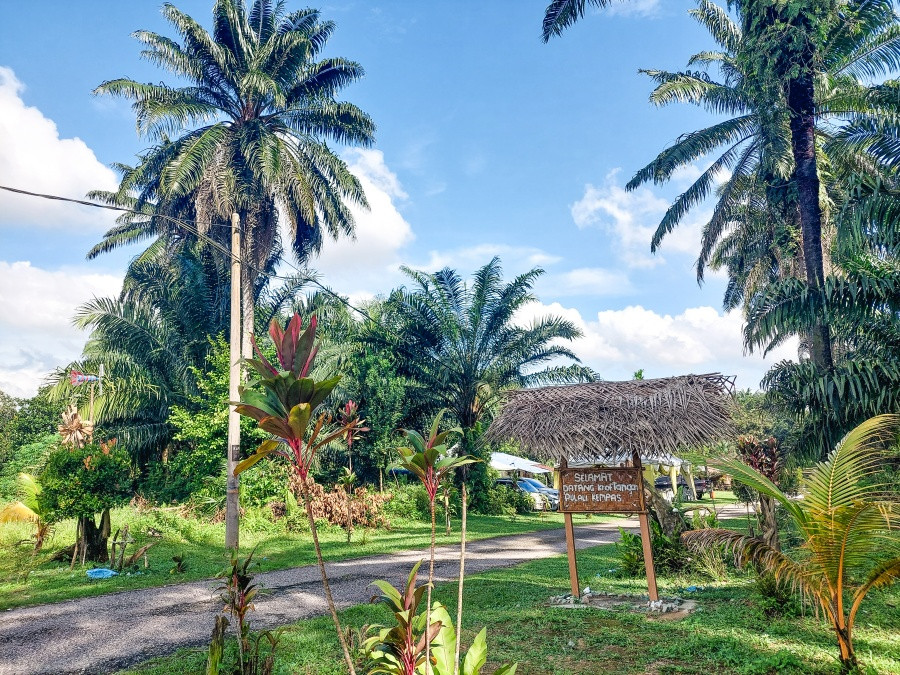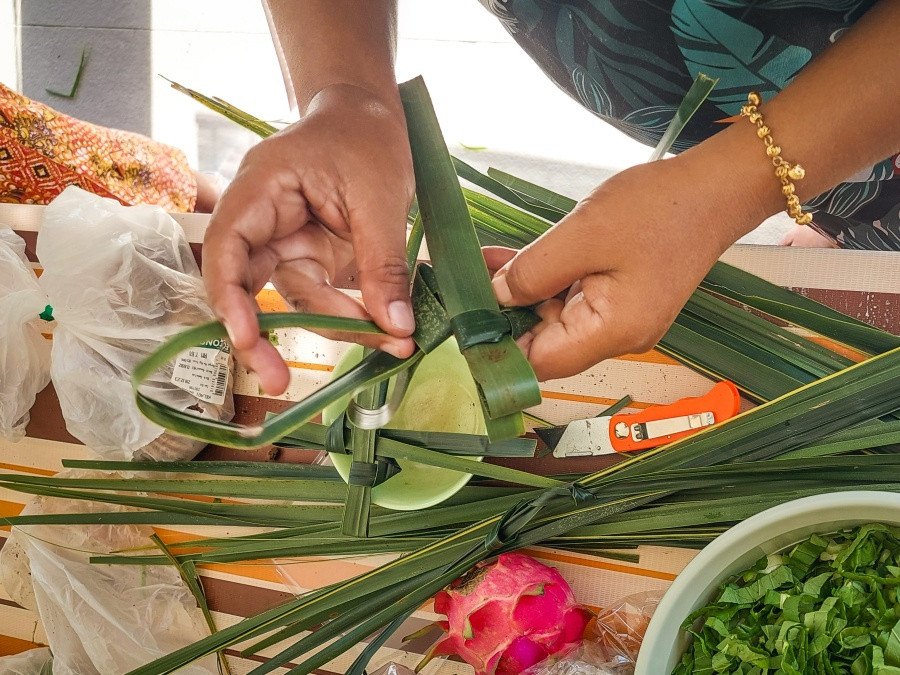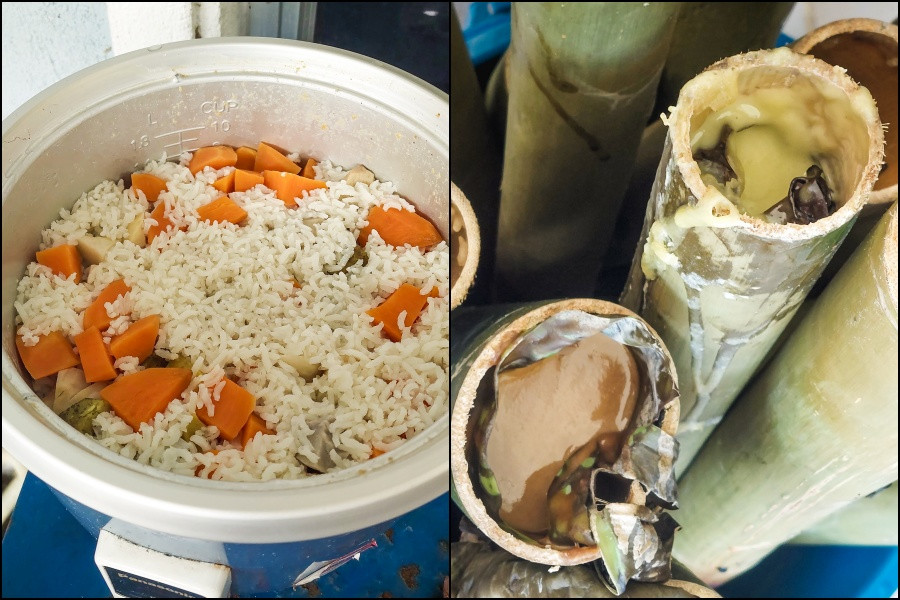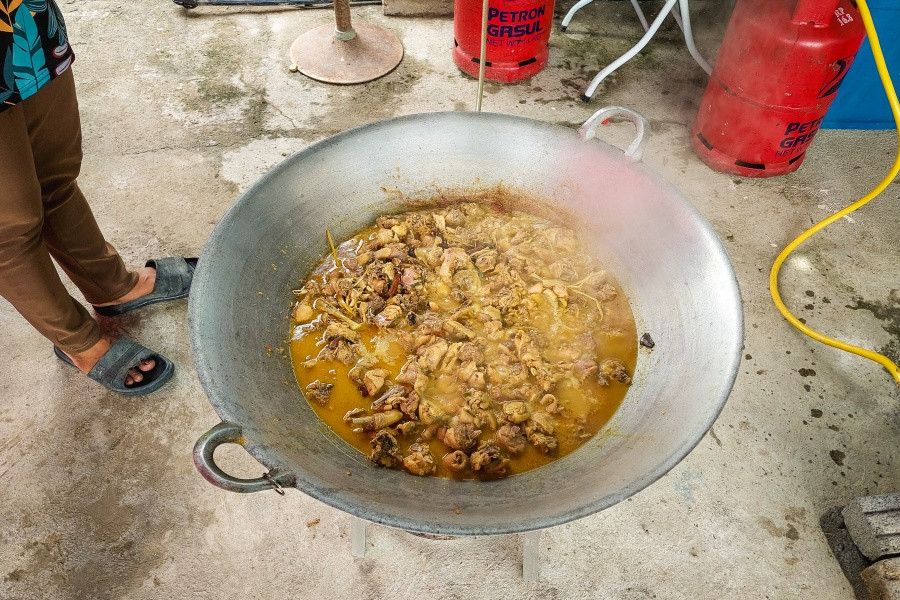A feast for Haik Muyang
by Syarifah Nadhirah11 Jan 2024
Each year, the Orang Asli Temuan in Kampung Pulau Kempas, Kuala Langat, celebrate the year’s abundance during Haik Muyang, a celebration marked by traditional indigenous foods and ancestral rituals.
Back in the ’80s, Lisa and Shaq Koyok—part of the Temuan community—recall a time when they used to traverse a ‘titi kayu’, a makeshift wooden pathway, spanning 500 meters from an abandoned factory to Kampung Pulau Kempas in Kuala Langat. Beneath the suspended wooden planks made from a large tree, water from the peat swamp inundated the area, turning Pulau Kempas into an ‘island’.
These days, the road towards Kuala Langat is flanked by palm oil trees and is freshly paved, bustling with cars and large trucks journeying between Banting and Cyberjaya. The recently constructed Gamuda Cove SplashMania—located not far from the Temuan villages—is probably the only reason for the path’s current polished appearance.
For the Temuan people in Kuala Langat, the annual Haik Muyang celebrations—held on December 29 each year—carries unparalleled significance as their most crucial day of observance.
“As you’ve gathered ample sustenance throughout the year, in return, your earnings are shared with the angels through a communal meal with your family and neighbours,” says Lisa when asked about the significance of the celebration. Rooted in agrarian lifestyle, every aspect of the celebration is intricately tied to maintaining a harmonious relationship with the land that provides for them.
Lisa and her family members do most of the preparations the night before to ease the lengthy cooking process the next day. “We typically hold an open house on a separate day from the other villages (referring to neighbouring villages eg Kampung Busut Baru, Kampung Bukit Cheeding and Kampung Kemandul) to ensure we have time to visit each other,” says Lisa as she expertly weaves ‘ketupat lepas’ utilised after the ritualistic ‘mandi bunga’ or floral bath. Her hands move briskly, working on two distinct types of ketupat, each symbolically crafted for the men and women of the community.
In a Temuan household, it is evident that both men and women participate in the preparation and cooking of food.
The day before
Haik Muyang primarily revolves around the act of communal food-sharing. Annually, Lisa and her in-laws cook traditional Temuan cuisine in addition to her well-known bihun sup. Amid our conversation, she gleefully presents nasi landau for dinner. The Temuan people traditionally cook rice with keledek, keladi, and ubi as substitutes. Their affinity towards these rooted plants gives way to the slight tinge of sweetness acquired from these starches. To complement the nasi landau is ubi lempaq featuring tapioca cooked with turmeric leaves and coconut milk. Harvested from their own backyard, the tubers are cubed and simmered in a large pot for an hour, resulting in a rich, white broth.
“This year, our attempt to make ubik kacau was unsuccessful, as it did not come to fruition due to adverse weather conditions,” says Shaq in discontent as he scoops the nasi landau from the pot. He explains that the extreme weather has undoubtedly altered their way of consumption, leaving less room for preservation of food indigenous to the land. We were lucky to taste ubik kacau the last time we visited his house, during which his mother and sister diligently prepared the traditional cassava dish that involved a labour-intensive process of fermentation, drying and roasting.
The night before the big day, rows of bamboo poles about a meter-long each are arranged on the table by Shaq and his brother-in-law Lezuri. Rain starts to pour again, and we take turns to gently lay the banana leaves over the heat from the fire pit. The softened leaves are then rolled and filled into the bamboo poles, ready for the marinated chicken fillings the next day. Traditionally, ayam masak dalam buluh is prepared with a distinctive ingredient—buah kulim—which imparts a slight bitterness and a robust garlic essence.
The day of the feast
Lezuri, Lisa’s husband, arranges the bamboo stalk near a bed of embers and lets it grill for about an hour until the exterior turns slightly pale brown, roughly gauging the readiness of the dish. Similarly, lemang tepung is cooked in bamboo with pandan or gula melaka as its main seasoning. The smooth and viscid texture of the lemang tepung seems to be the perfect way to end the feast. As we continue to savour the food, Shaq explains that in Temuan belief, it is not customary to describe the taste of the food one is eating while in the forest, so as not to attract ‘semangat-semangat’ or spirits that might devour it. Instead, one should prepare food for the spirits separately beforehand.
Soon after, Tok Batin Raman Bin Pahat, the village head, arrives at Lisa’s family house to extend his greetings. Observing each household’s ‘rumah sangga,’ a small house for angel and ancestor worship, Batin Raman emphasises its significance as a place for prayers.
“Each house has a ‘sangga house’, to offer prayers to the ancestors and angels. Prayers are made to the ancestors to seek their blessings as the new year approaches—for long life, abundance of blessings, with new resolutions and desired aspirations,” he says.
A huge part of Haik Muyang is dedicated to the ‘sembahyang kubur’ ritual on the morning of December 28 at the graveyard situated near the village entrance. Prayers are made to their ancestors to express gratitude and implore for continued good health and abundance of wealth. Following this, a ‘mandi bunga’ ritual cleanses the body upon returning, avoiding resinous flowers due to their poisonous nature. The water bath, filled in a ‘tempayan’ adorned with nipah leaf weaving, is placed beside the ‘rumah sangga.’
The Temuan people continue to practise their beliefs in ways that they can. “The celebration of Haik Muyang is indeed not widely known. I hope the younger [Temuan] generation continues to inform outsiders about our customs and how important it is for us to preserve them,” says Batin Raman as we part ways.
***
An architect by practice, Syarifah Nadhirah practices as a visual artist, and currently serves as a creative director at Forest House. She has also catalogued Malaysia’s edible plants in her book, ‘Recalling Forgotten Tastes’.
Read next
The joy and creativity in veganising Malaysian food
Veganising Malaysian favourites

Telling a tale of the land
Q&A with Syarifah Nadhirah

The phenomenon of Dayak barbecue in Sarawak
The history and evolution of Dayak BBQ









